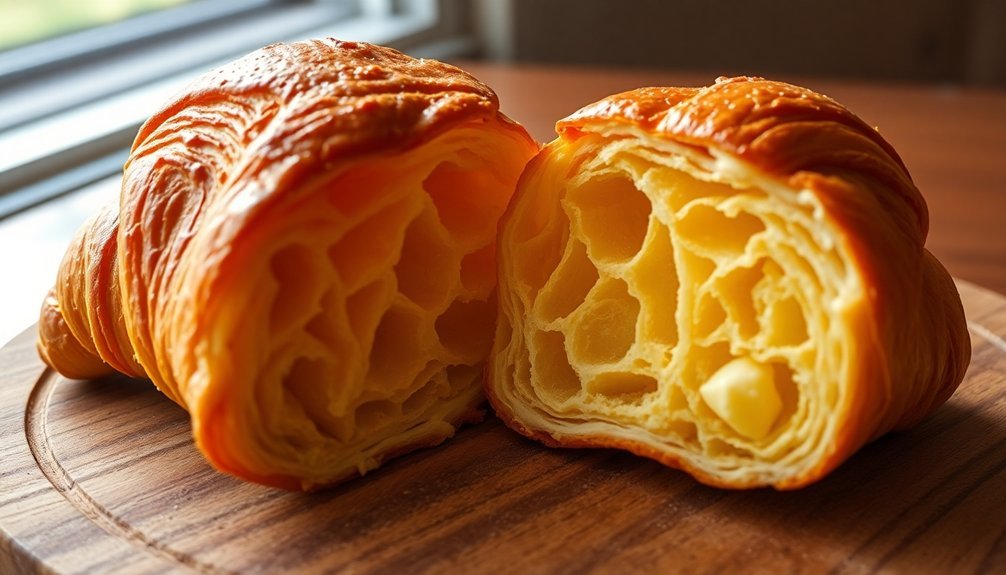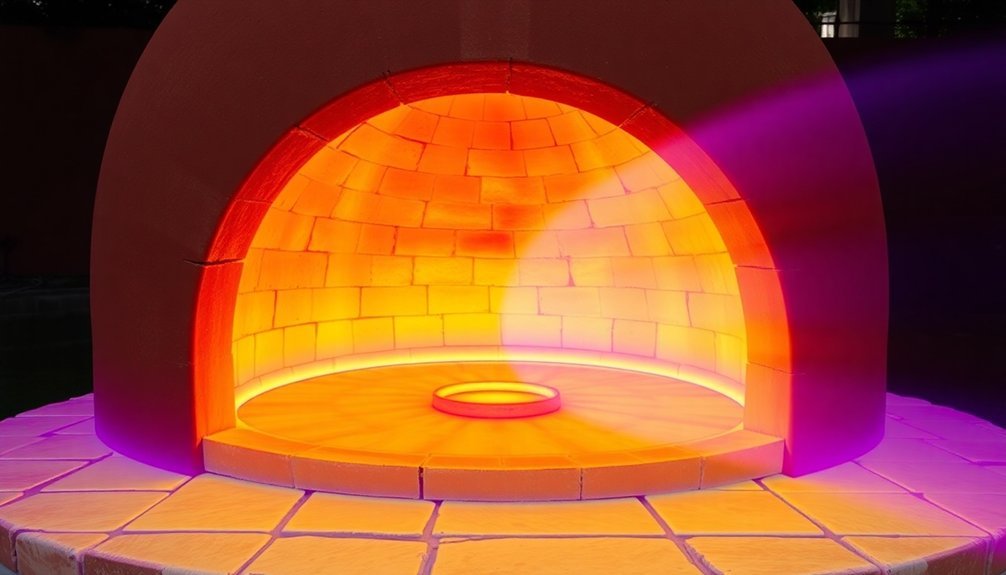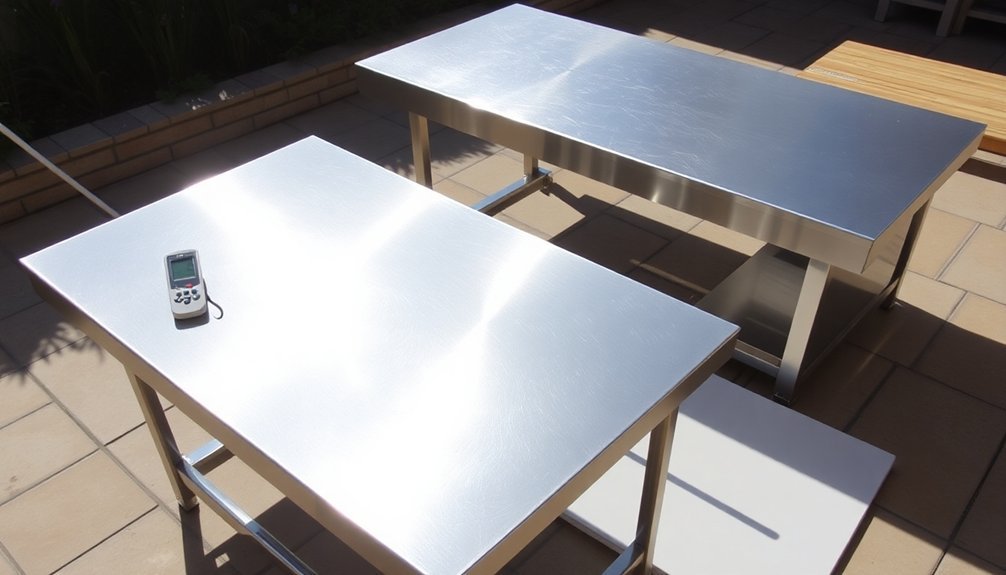Solar baked croissants get their light and flaky texture from a precise combination of concentrated sunlight and temperature control. You'll need large silver mirrors to capture and focus sunlight, reaching ideal baking temperatures up to 300°C. The key lies in proper butter lamination – keeping your European-style butter cold (55-60°F) while working in a cool environment below 77°F. You'll want to protect your dough during proofing, maintaining 75-80°F with proper humidity for 4-5 hours. Understanding these temperature relationships and lamination techniques will reveal the secret to perfectly layered, airy croissants.
The Solar Baking Environment

How does a solar-powered bakery manage to produce perfect croissants without traditional ovens? The secret lies in an innovative system of large silver mirrors that capture and concentrate sunlight, creating temperatures up to 300 degrees Celsius – perfect for baking delicate pastries.
You'll find this sustainable baking system operates through a sophisticated heat exchange mechanism. The mirrors collect and magnify the sun's rays, transferring this intense heat through a specialized fluid that powers the oven. It's this precise heat control that helps create the perfect baking environment for your croissants' signature flaky layers. The innovative design was developed by Toufic Hamdan, who created this revolutionary solar-powered convection oven specifically for bakeries.
However, you'll need to take into account that this technology requires specific conditions to work effectively. You can't operate the system on cloudy days or with diffuse radiation, as direct sunlight is essential for achieving the necessary temperatures.
If you're planning to use solar baking technology, you'll want to verify your location has consistent sunshine. During severe weather conditions, such as hailstorms, you'll need to dismantle and store the mirrors indoors to protect the equipment.
But with proper training and technical support, you can master this eco-friendly baking method.
Butter Lamination Under Solar Heat
The art of butter lamination presents unique challenges in a solar-powered bakery. You'll need to maintain precise temperature control to keep your butter at that perfect state where it bends without breaking, which can be tricky when working with solar heat. European-style butter, with its higher fat content, is your best choice for creating those sought-after flaky layers. Using cold unsalted butter ensures proper lamination and optimal results. During the lamination process, you'll need to work efficiently while ensuring your butter stays cold. If you notice your butter warming up, don't hesitate to pause and refrigerate it for 10-15 minutes.
When you're enclosing the butter block in your dough, make sure it's perfectly aligned to achieve even layers throughout your croissants. As you perform each fold and roll, handle the dough gently to prevent the butter from breaking or squeezing out to the sides.
Temperature Control While Solar Baking

Mastering temperature control stands as a critical challenge when baking croissants in a solar oven.
You'll need to preheat your solar oven for 20 minutes and guarantee it maintains a stable temperature before adding your croissants. If you're baking on a windy day, protect your oven from cold drafts that can extend cooking time.
To achieve even heating, you'll want to rotate your baking pan every 15 minutes, making quarter turns. Choose a parabolic solar oven for optimal results when baking pastries.
Using parchment paper helps distribute heat evenly and prevents your croissants from sticking. You'll need to adjust the oven's position throughout the baking process to maintain consistent solar intensity.
Don't let your croissants overheat. If the sun becomes too intense, shield them with a light cloth and monitor their color and texture closely.
You'll need to modify baking times based on your oven's efficiency and weather conditions.
Once they're done, remove your croissants immediately and transfer them to a cooling rack.
Let them cool in a draft-free area to preserve their flaky texture.
You'll want to store them in an airtight container, keeping them away from direct sunlight and heat to maintain freshness.
Proofing With Natural Warmth
Successful proofing begins with creating an environment that mimics nature's perfect conditions. You'll need to maintain a temperature between 75-80ºF (24-27ºC), similar to a warm, gentle morning sun.
When using natural warmth for proofing, you must protect your dough from direct sunlight, which can overheat and melt the butter layers.
Create a humid microclimate by placing your croissants in a plastic proofing bag or covering them with plastic wrap. You're aiming for about 80% humidity to prevent skin formation on the dough.
Watch for the telltale signs of proper proofing: your croissants should become puffy and develop a slight jiggle when gently shaken. You'll also notice visible layers forming as the dough expands.
Monitor the proofing process for 4-5 hours, rotating your trays periodically to guarantee even temperature distribution.
If you're proofing outdoors, choose a sheltered spot away from direct heat. Keep a digital thermometer handy to check that the temperature stays consistent.
Perfect Solar Baked Layers

Creating perfect layers in solar baked croissants demands precise temperature control and careful handling throughout the baking process.
You'll need to maintain your working environment below 77°F (25°C) and guarantee your butter stays between 55-60°F (13-15°C) for ideal lamination.
When you're ready to create layers, roll your dough into a rectangle and place the butter in the middle. You'll want to fold the dough to completely encase the butter, then perform three separate folds, making sure to refrigerate between each one.
Don't press the butter into the dough – instead, use gentle, even pressure with your rolling pin to maintain distinct layers.
To prevent common issues, you'll need to work quickly and efficiently. If your butter's too cold, it'll shatter; too warm, and it'll incorporate into the dough, destroying your layers.
Keep rotating your dough 45° as you work, and lightly flour your surface to prevent sticking. Remember to trim the edges for even layering, and don't skip the egg wash before solar baking – it's essential for achieving that signature golden-brown shine.
Frequently Asked Questions
Can I Use Margarine Instead of Butter for Solar-Baked Croissants?
While you can use margarine, it won't give you the same rich flavor and flaky texture as butter. You'll get a curved shape and less desirable results, so it's better to stick with high-fat butter.
How Do Weather Conditions Affect the Timing of Solar Croissant Baking?
You'll need to adjust your baking time based on cloud cover, temperature, and humidity. Cloudy days require longer baking, while high temperatures mean shorter times. Monitor humidity closely to prevent dough from drying out.
What Type of Solar Oven Works Best for Baking Croissants?
You'll get the best results using a parabolic solar cooker, as it reaches temperatures up to 350°F and maintains consistent heat. Make sure it has reflective surfaces and good insulation for ideal croissant baking.
Does Altitude Impact the Success of Solar-Baked Croissants?
Yes, altitude greatly affects your solar-baked croissants. You'll need to adjust leavening agents, increase liquids, and monitor proofing carefully. At higher altitudes, the dough will rise faster and lose moisture quicker.
Are There Special Storage Requirements for Solar-Baked Croissants?
You'll store solar-baked croissants just like regular ones. Keep them in an airtight container at room temperature for 2 days, refrigerate for up to a week, or freeze them for 2 months.
In Summary
You'll find that successful solar-baked croissants rely on carefully managing the unique heating environment. By adjusting your solar oven's temperature and timing, you're able to achieve that signature flaky texture through proper butter lamination. While it takes practice to master the proofing and baking stages under natural warmth, your patience will be rewarded with perfectly layered, light, and airy croissants.





Leave a Reply